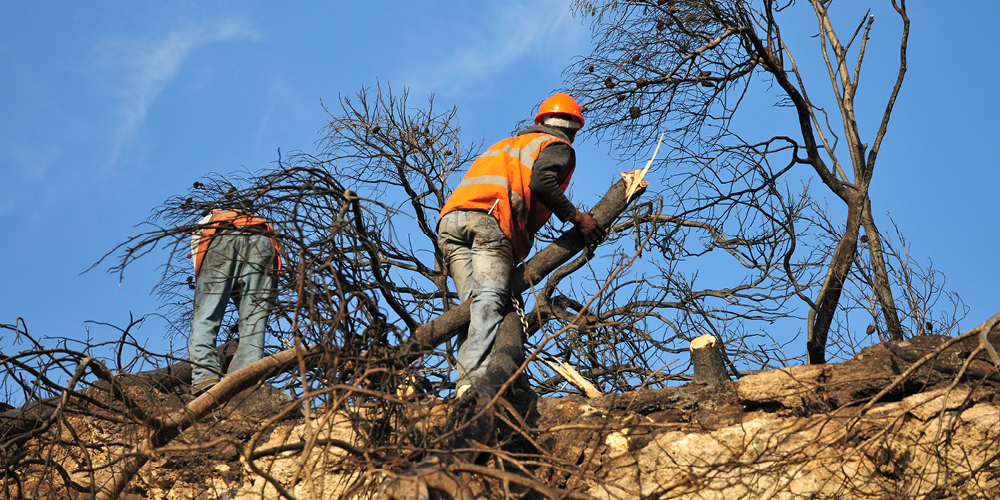Activate your wildfire emergency response plan
ArticleAugust 19, 2021
This article was developed by Zurich’s U.S. Risk Engineering colleagues.
A wildfire has been reported in your area and may be headed your way. You may only have hours until you learn firsthand whether your preparations will be adequate to the task of preventing or limiting damage to your business and ensuring against danger to your employees. It is time to activate all aspects of your wildfire response plan.
Monitor alerts
It is likely that outside sources such as local news outlets and government alerts will be your first notification of a wildfire emergency. If you receive a report from an onsite employee or an offsite contact and are uncertain whether local authorities are aware of the threat, report it immediately.
If it appears likely that a wildfire may affect your location, begin taking the following actions:
- Monitor information sources such as local news reports and government websites for updates and alerts.
- Be aware of local weather conditions, such as wind speed, wind direction, humidity, and temperature.
- Review your plan’s wildfire triggers and be ready to activate them.
- Discuss wildfire duties with assigned staff (typically fire team members) and verify the needed staff will be available and ready for action.
- Visually review the open space around your facility and clear away any unnecessary combustibles.
- Maintain communication with all staff members to keep them informed and ready for evacuation, if required.
Assemble your wildfire response team
- Immediately make sure that all trained wildfire team members are available and ready to complete their assigned duties.
- Review all emergency shutdown and evacuation procedures with your team.
Prepare your property
- Shut down building air intakes to prevent smoke, soot and possibly embers from entering your facility. Some facilities will have air intakes with smoke detectors designed to automatically shut down air intakes. If your facility is not so equipped, make sure it is done manually if the location is to be evacuated.
- Close and seal building openings to prevent smoke or soot from entering the facility, including docks, garages, personnel doors, air intake louvers, kitchen vents in cafeterias, and other potential openings.
- Clear a defensible space by relocating combustible yard storage at least 100 feet away from buildings and important outdoor structures to reduce risk if combustible materials are ignited.
- If appropriate, relocate combustible yard storage offsite or indoors where equipped with automatic sprinklers of appropriate design.
Initiate safe shutdown procedures
If your business is in an area at risk of wildfires, you should already have a shutdown sequence and procedure prepared for the emergency. You should know how long the process will take and what potential glitches may occur. The shutdown procedure should include:
- Back up data to capture any data created since your last scheduled backup. Make sure your data is saved in the cloud or at a remote data facility.
- Remove critical tools, dies and records to locations offsite. If your facility is damaged by the wildfire, your recovery time will be faster if such items and materials are not lost. This may enable you to continue limited operations in a temporary location where suitable production machinery is available.
- Shut down all utilities, including fuel gas supplies and electric power. However, ensure that all fire-suppression systems, such as sprinklers, remain in operation.
When the time comes, evacuate!
Finally, a critical component of any wildfire response plan is knowing when it’s time to evacuate your people. Usually, the order will come from civil authorities. When it does, you must act immediately no matter the status of your shutdown procedures and preparations. Property can be restored. Lives cannot.
Employees should evacuate following pre-planned escape routes worked out well in advance of a wildfire event. And remember that wildfires are often fast-moving, unpredictable, and likely to spawn satellite fires due to airborne embers that can become life-threatening in minutes. So, when the order is given, GO!
These actions should be part of a fully developed wildfire Emergency Response Plan (ERP). The articles below detail the risks of wildfires and the other major components of a wildfire ERP. Taken together, they can provide your business with a path to reduced risks and faster recovery.
The information in this publication was compiled from sources believed to be reliable for informational purposes only. All sample policies and procedures herein should serve as a guideline, which you can use to create your own policies and procedures. We trust that you will customize these samples to reflect your own operations and believe that these samples may serve as a helpful platform for this endeavor. Any and all information contained herein is not intended to constitute advice (particularly not legal advice). Accordingly, persons requiring advice should consult independent advisors when developing programs and policies. We do not guarantee the accuracy of this information or any results and further assume no liability in connection with this publication and sample policies and procedures, including any information, methods or safety suggestions contained herein. We undertake no obligation to publicly update or revise any of this information, whether to reflect new information, future developments, events or circumstances or otherwise. Moreover, Zurich reminds you that this cannot be assumed to contain every acceptable safety and compliance procedure or that additional procedures might not be appropriate under the circumstances. The subject matter of this publication is not tied to any specific insurance product nor will adopting these policies and procedures ensure coverage under any insurance policy.



